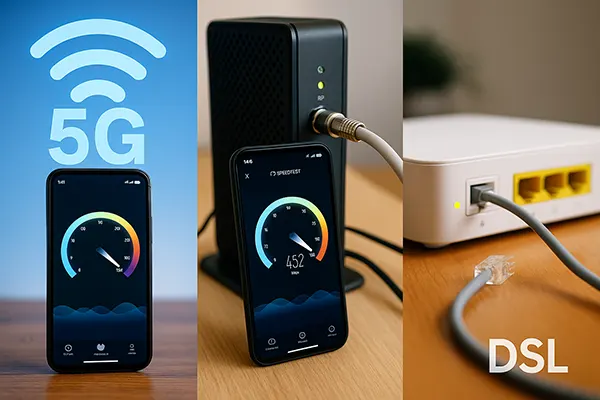Which Internet Is Faster During Peak Hours: 5G, Cable or DSL? A Real Test Across Three German Cities

In an age of remote work, streaming and smart devices, choosing the right internet connection is critical. But how do 5G, cable and DSL perform during the most demanding time of the day – the evening peak hours? To find out, we conducted real-life speed and latency tests in Berlin, Munich and Hamburg, comparing the three technologies side by side.
Methodology and Testing Setup
To ensure accuracy, we performed standardised tests in all three cities in February 2025 between 7:00 PM and 9:00 PM, the typical high-traffic period for internet use. Each test measured download speed, upload speed and latency using Ookla’s Speedtest, on the same devices and servers where possible.
The 5G connection was tested using a Samsung Galaxy S24 Ultra on Deutsche Telekom’s 5G standalone network. Cable tests were conducted using Vodafone’s DOCSIS 3.1 network, while DSL used Deutsche Telekom’s VDSL2 (50 Mbps profile). We performed 10 tests per location for each connection type.
All environments were indoors with good signal conditions and stable connections. The results were averaged to provide a comprehensive view of real-world performance.
Overview of Germany’s Internet Infrastructure
Germany is known for its advanced yet regionally variable internet infrastructure. While major cities have wide access to fibre and 5G networks, many users still rely on legacy DSL connections, especially in older buildings or suburban zones.
5G standalone networks, launched nationally in 2023, have seen accelerated adoption in urban hubs. Meanwhile, DOCSIS 3.1 cable internet remains a strong choice for stable, high-speed fixed connections. VDSL2, although older, continues to serve millions of German households with moderate performance.
This comparison helps shed light on which technology offers the best balance of speed, latency and reliability when it matters most: under pressure from simultaneous household use.
Performance Results: Speed and Latency Comparison
In Berlin, 5G achieved the highest download speeds during peak hours, averaging 460 Mbps, followed by cable at 390 Mbps. DSL lagged far behind at just 42 Mbps. Upload speeds followed a similar pattern: 5G reached 85 Mbps, cable 45 Mbps, and DSL only 10 Mbps.
Munich showed similar trends, although cable slightly outperformed 5G in consistency. Average download speeds were 430 Mbps (cable), 410 Mbps (5G), and 39 Mbps (DSL). Hamburg results mirrored Berlin’s, with 5G again leading the pack with peak speeds of 480 Mbps.
Latency was lowest on cable (average 18 ms), followed closely by 5G (21 ms), while DSL connections suffered from higher latency around 43 ms. For real-time applications like video calls or online gaming, these differences significantly impact user experience.
Reliability and Connection Drops
5G showed higher fluctuation during tests in indoor areas, especially in buildings with thick walls. While fast, it experienced occasional dips in speed, particularly in older residential blocks of Munich.
Cable proved the most stable across all three cities, delivering consistent speeds with minimal packet loss. This stability makes it suitable for households with multiple users or streaming devices.
DSL connections, while generally stable, showed frequent buffering issues when more than one device streamed HD content simultaneously. In addition, upload speeds were insufficient for modern cloud-based work tasks.

Cost and Availability in Urban Areas
5G home internet plans in Germany now average around €45–55/month with unlimited data, making it a competitive alternative to cable. However, coverage quality can vary depending on provider and neighbourhood signal strength.
Cable plans remain the most popular for urban households, typically costing €35–50/month with speeds exceeding 400 Mbps. Installation is usually straightforward, and services are widely available even in older city centres.
DSL remains the cheapest at €25–35/month, but its speed limitations make it increasingly obsolete, especially for families or remote professionals needing higher upload capacity and streaming stability.
Which Connection Is Right for You?
If you prioritise speed and mobility, 5G is a strong option – especially in buildings with strong signal access and fewer obstructions. It’s ideal for single users or smaller households in modern apartments.
Cable is still the best all-rounder for reliability and consistent performance. It suits medium to large households with high data needs and multiple devices running concurrently.
DSL may be a viable choice for basic browsing or emailing but is ill-suited for heavy streaming or upload-dependent tasks. In 2025, it’s best seen as a backup rather than a primary solution.
